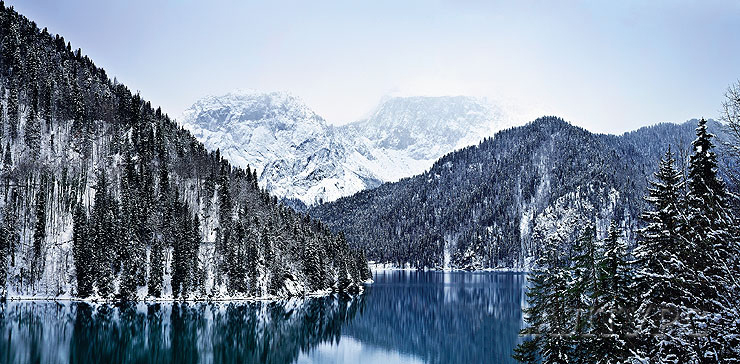
Paradise for tourists. Lake Ritsa
Lake Ritsa is definitely the most famous sight in the mountains of Abkhazia and its natural symbol. Going on summer excursions to Ritsa is a tradition and a must do for holidaymakers and tourists. But not everyone is able to feast his eyes on the ice-bound Ritsa and the snow-covered mountain slopes around it in winter. The upper sections of the road which starts almost at the seaside and goes along the Bzyb River up to 950meters above sea level are covered by snow. Ritsa is located in the northern part of Abkhazia, it is a lake in the Caucasus Mountains, surrounded by mixed mountain forests and subalpine meadows. Its water is cold and clear. Mountains with heights of 2,200 to 3,500 m surround the lake.
The region around Lake Ritsa is a part of the Euxine-Colchic deciduous forests ecoregion with a fairly high concentration of evergreen boxwoodgroves. Many specimens of the Nordmann Fir, which reach heights of over 70 meters (230 ft), are found around the lake.
Ritsa is situated about 950 meters above sea level; the length of the lake is about 2000m and the deepest point is 150m. In summer the temperature of its water reaches +17/+20 degrees and in the coldest winters it is ice-bound. Unlike Malaya Ritsa there is trout in the lake.
Local hunters and cattlemen had known about the lake for a long time but it was marked on a map only in 1865. The first explorers came to Ritsa in 1919 and in 1930 the lake became a tourist attraction. Many mountain routs start up from Ritsa and then divide into paths, forests andranges of the nearest mountains.
In 1930 the Ritsa Nature Reserve (162.89 km²) was established to protect the natural state of the lake and the surrounding land. The roadfrom the Black Sea coast was built in 1936. The lake was an important tourist attraction during the Soviet period. It is still frequented by Russian tourists.
Lake Ritsa is fed by six rivers and drained by one, the Iupshara River. The resort of Avadhara lies to the north of the lake. The Soviet dictatorJoseph Stalin had one of his summer-houses (dacha) by the lake. Today this dacha belongs to the Abkhazian government.
Ritsa Legend.

In ancient times there was a valley and a river at the site of the modern lake. A girl named Ritsa lived there with three brothers Agepsta, Atsetuka and Pshegishkha. Ritsa used to pasture her animals in the valley and her brothers hunted in the high mountains by day and returned to the valley in the evening, where they ate and sang folk songs.
One day the brothers went too far into the mountains. Ritsa missed them and sang. The forest robbers Gega and Iupshara heard her and decided to kidnap her. Iupshara caught her and rode down the valley, while Gega covered his flank. Ritsa's brothers heard her crying and came to the rescue.
Pshegishkha threw a sword at the robbers, but he missed and the sword flew over the river. The valley was filled with water and turned into a lake. Ritsa broke from Iupshara's grip, but fell into the lake. The brothers couldn't save her. Then Pshegishkha threw the robber Iupshara into the lake, but Ritsa's water wouldn't accept him and threw out him over Pshegishkha's sword and the water carried him away to the sea. Gega ran after Iupshara, but he didn't manage to rescue him.
Out of grief, the brothers turned into mountains, and today they are still standing here to protect the resting-place of Ritsa.
In the 1930s, during the construction of Stalins's dacha, soldiers carried building materials by the lacet. Once, in the most dangerous place, one truck fell down from the lacet. As the truck was falling, the driver cried: "Goodbye, Motherland!" So, today this place is named "Goodbye, Motherland!" among drivers.












